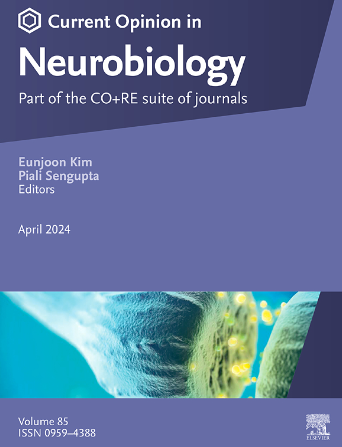突触多室组织中的相分离。
IF 4.8
2区 医学
Q1 NEUROSCIENCES
引用次数: 0
摘要
神经元突触是由释放一个神经元的突触前按钮的递质与接收另一个神经元的脊柱突起等突触后间隔的递质并置而形成的。每个突触前钮扣和突触后棘虽然体积很小,但它们被进一步划分为具有不同分子组织和突触功能的微/纳米结构域。本文综述了近年来的研究表明,多价蛋白-蛋白相互作用诱导的相分离是微小突触内多种不同分子凝聚物形成和共存的基础。在突触后,通过相分离首次证明了突触区隔化,相分离允许传递受体聚集到不同的纳米结构域,并使突触后密度受到突触刺激信号的调节,以实现可塑性。在突触前,这种相分离介导的突触凝聚物的形成使sv被储存为不同的池,并直接运输以供活性诱导的递质释放。本文章由计算机程序翻译,如有差异,请以英文原文为准。
Phase separation in the multi-compartment organization of synapses
A neuronal synapse is formed by juxtaposition of a transmitter releasing presynaptic bouton of one neuron with a transmitter receiving postsynaptic compartment such as a spine protrusion of another neuron. Each presynaptic bouton and postsynaptic spine, though very small in their volumes already, are further compartmentalized to micro-/nano-domains with distinct molecular organizations and synaptic functions. This review summarizes studies in recent years demonstrating that multivalent protein–protein interaction-induced phase separation underlies formation and coexistence of multiple distinct molecular condensates within tiny synapses. In post-synapses where synaptic compartmentalization via phase separation was first demonstrated, phase separation allows clustering of transmitter receptors into distinct nanodomains and renders postsynaptic densities to be regulated by synaptic stimulation signals for plasticity. In pre-synapses, such phase separation-mediated synaptic condensates formation allows SVs to be stored as distinct pools and directly transported for activity-induced transmitter release.
求助全文
通过发布文献求助,成功后即可免费获取论文全文。
去求助
来源期刊

Current Opinion in Neurobiology
医学-神经科学
CiteScore
11.10
自引率
1.80%
发文量
130
审稿时长
4-8 weeks
期刊介绍:
Current Opinion in Neurobiology publishes short annotated reviews by leading experts on recent developments in the field of neurobiology. These experts write short reviews describing recent discoveries in this field (in the past 2-5 years), as well as highlighting select individual papers of particular significance.
The journal is thus an important resource allowing researchers and educators to quickly gain an overview and rich understanding of complex and current issues in the field of Neurobiology. The journal takes a unique and valuable approach in focusing each special issue around a topic of scientific and/or societal interest, and then bringing together leading international experts studying that topic, embracing diverse methodologies and perspectives.
Journal Content: The journal consists of 6 issues per year, covering 8 recurring topics every other year in the following categories:
-Neurobiology of Disease-
Neurobiology of Behavior-
Cellular Neuroscience-
Systems Neuroscience-
Developmental Neuroscience-
Neurobiology of Learning and Plasticity-
Molecular Neuroscience-
Computational Neuroscience
 求助内容:
求助内容: 应助结果提醒方式:
应助结果提醒方式:


